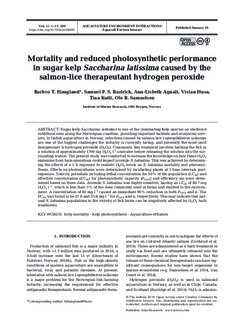| dc.contributor.author | Haugland, Barbro Taraldset | |
| dc.contributor.author | Rastrick, Samuel | |
| dc.contributor.author | Agnalt, Ann-Lisbeth | |
| dc.contributor.author | Husa, Vivian | |
| dc.contributor.author | Kutti, Tina | |
| dc.contributor.author | Samuelsen, Ole Bent | |
| dc.date.accessioned | 2019-03-06T10:19:39Z | |
| dc.date.available | 2019-03-06T10:19:39Z | |
| dc.date.created | 2019-02-28T15:24:48Z | |
| dc.date.issued | 2019 | |
| dc.identifier.citation | Aquaculture Environment Interactions. 2019, 11 1-17. | nb_NO |
| dc.identifier.issn | 1869-215X | |
| dc.identifier.uri | http://hdl.handle.net/11250/2588958 | |
| dc.description.abstract | Sugar kelp Saccharina latissima is one of the dominating kelp species on sheltered sublittoral sites along the Norwegian coastline, providing important habitats and ecosystem services. In finfish aquaculture in Norway, infections caused by salmon lice Lepeophtheirus salmonis are one of the biggest challenges the industry is currently facing, and presently the most-used therapeutant is hydrogen peroxide (H2O2). Commonly, this treatment involves bathing the fish in a solution of approximately 1700 mg H2O2 l-1 seawater before releasing the solution into the surrounding waters. The present study was conducted to increase the knowledge on how these H2O2 emissions from farm operations could impact juvenile S. latissima. This was achieved by determining the effects of a 1 h exposure to realistic H2O2 levels on S. latissima mortality and photosynthesis. Effects on photosynthesis were determined by incubating plants at 3 time intervals post-exposure. Toxicity potentials including lethal concentration for 50% of the population (LC50) and effective concentration (EC50) for photosynthetic capacity (PMAX) and efficiency (α) were determined based on these data. Juvenile S. latissima was highly sensitive, having an LC50 of 80.7 mg H2O2 l-1, which is less than 5% of the dose commonly used at farms and emitted to the environment. A concentration of 85 mg l-1 caused an immediate 90% reduction in both PMAX and α. The EC50 was found to be 27.8 and 35.4 mg l-1 for PMAX and α, respectively. This may indicate that natural S. latissima populations in the vicinity of fish farms can be negatively affected by H2O2 bath treatments. | nb_NO |
| dc.language.iso | eng | nb_NO |
| dc.title | Mortality and reduced photosynthetic performance in sugar kelp Saccharina latissima caused by the salmon-lice therapeutant hydrogen peroxide | nb_NO |
| dc.type | Journal article | nb_NO |
| dc.type | Peer reviewed | nb_NO |
| dc.description.version | publishedVersion | nb_NO |
| dc.source.pagenumber | 1-17 | nb_NO |
| dc.source.volume | 11 | nb_NO |
| dc.source.journal | Aquaculture Environment Interactions | nb_NO |
| dc.identifier.doi | 10.3354/aei00292 | |
| dc.identifier.cristin | 1681518 | |
| dc.relation.project | Norges forskningsråd: 228871 | nb_NO |
| dc.relation.project | Havforskningsinstituttet: 14907 | nb_NO |
| cristin.unitcode | 7431,12,0,0 | |
| cristin.unitname | Bentiske ressurser og prosesser | |
| cristin.ispublished | true | |
| cristin.fulltext | original | |
| cristin.qualitycode | 1 | |
